Liu Ke Dian
New Tech Institute, China
Correspondence to: Liu Ke Dian, New Tech Institute, China.
| Email: |  |
Copyright © 2025 The Author(s). Published by Scientific & Academic Publishing.
This work is licensed under the Creative Commons Attribution International License (CC BY).
http://creativecommons.org/licenses/by/4.0/

Abstract
Based on a newly discovered universal static thermal repulsive force (field) theory [3] and a newly proposed novel atom model [4], this paper aims to accurately reinterpret the superconductivity and some other controversial assertions of physics and some physical phenomena: - The macroscopic and microscopic frictional forces are clarified and redefined as being the universal thermal repulsive force. - The principle of thermoelectric effect being exact the same principle of the conventional refrigeration technology by using conventional refrigerants is explained based on the universal thermal repulsive force theory. - Since the macroscopic and microscopic frictional forces are clarified as being the universal static thermal repulsive force, therefore, the electrical resistance is actually the thermal repulsive force between electrons and nucleus, thus reinterpreting the actual cause of superconductivity as a decrease in thermal repulsive force (resistance) due to a decrease in temperature. Therefore, the reduction of the thermal repulsive force and higher moving velocity of electrons makes the motion of the electrons an adiabatic process, so there is no heat of energy bleeds away in superconducting state. - Some arguable conclusion for some physical phenomena and some controversial assertions of physics are researched and reinterpreted by the universal thermal repulsive force theory.
Keywords:
Superconductivity, Frictional force, Thermoelectric, Peltier effect, Seebeck effect, Thermal repulsive force
Cite this paper: Liu Ke Dian, Reinterpreting and Re-clarifying the Superconductivity and Some Other Controversial and Arguable Assertions and Phenomena of Physics Based on a Newly Discovered Universal Thermal Repulsive Force (Field) and a Newly Proposed Atom Model, International Journal of Theoretical and Mathematical Physics, Vol. 15 No. 1, 2025, pp. 10-26. doi: 10.5923/j.ijtmp.20251501.03.
1. Introduction
1.1. General Description
Since a universal thermal repulsive force (field) had been discovered on 2022 [3] and a novel atom model had been proposed on 2023 [4], we then have more alternative reasonable practical thinking mode by which we could reinterpret several physical phenomena and arguable assertions of physics more accurately therefore to reach more accurate more reasonable redefinition and re-description.
1.2. Briefing the Key Points of the New Discovered Universal Thermal Repulsive Force (Field) [3]
1) General definition: The Universal static thermal repulsive forces are existed in between any microscopic elementary particle (such as electrons, atoms and molecules), between any macroscopic matters, including the Sun, the earth, the stars and galaxies in the universe.It is one of the fundamental forces of nature. It is one of decisive foundation of existence of the universe and matter.2) Every atom or molecule of gas is a particle source or point source of the universal static thermal repulsive force field. When a particle’s size (including electron) is equal to or smaller than any molecular size, it acts as a point source of the thermal repulsive force (field).3) The Thermal repulsive force fields of a matter is the sum of thermal repulsive force fields of all point sources on the surface of the matter.4) The magnitude of the thermal repulsive force is proportional to its temperature, T (in Kelvin scale), and is inversely proportional to the distance or its mechanics radii, r, from the point heat source. It is not a function of molecule size and particle mass. The general form of the equation can be written as: | (1.2.1) |
where the kmT is the coefficient constant,  is power of r, T is the temperature in Kelvin. When the distance between two objects is longer comparing with the size of the objects,
is power of r, T is the temperature in Kelvin. When the distance between two objects is longer comparing with the size of the objects,  approaches 2, i.e.,
approaches 2, i.e., | (1.2.2) |
When the distance between two objects is shorter comparing with the size of the objects,  approaches 3, the Frepulsive should be
approaches 3, the Frepulsive should be  , i.e.,
, i.e., | (1.2.3) |
Diagram to illustrate the statements is shown as Fig.1.1.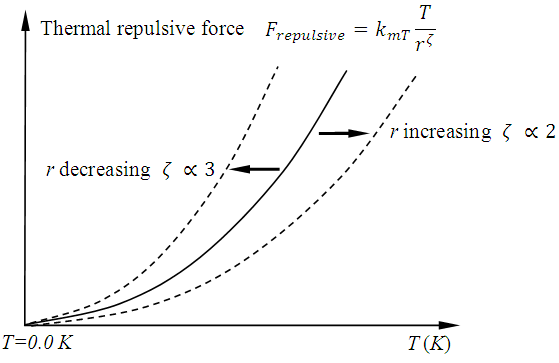 | Figure 1.1 |
5) The Thermal repulsive force fields between two matters or between two point soures are automatically acting on an equilibrium surface, which has a distance proportional to the strength of each force field. In other words, the repulsive force field is acting –reacting directly on the fields not acting reacting on the point, as shown in Fig.1.2.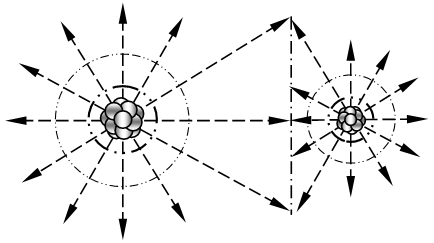 | Figure 1.2 |
1.3. Briefing the Structure of the Novel Atom Model [4] (Differing from Any Prevailing Model)
In the novel atom model, the nucleus-electrons system is in a static equilibrium state between a universal static thermal repulsive conservative force and Coulomb force. The sum of repulsive forces and Coulomb forces is distributed similar to an standing wave in radial direction of spatial spherical surface layers (like layers of onion), and is the so called energy level, as shown in Fig.1.3.1, 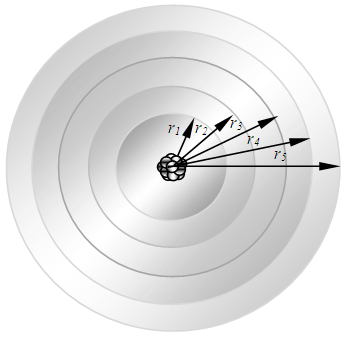 | Figure 1.3.1 |
The distributions of the Coulomb force and the Thermal repulsive force are shown as Fig.1.3.2, where the FCF expresses the Coulomb force and FthermRF expresses the thermal repulsive force.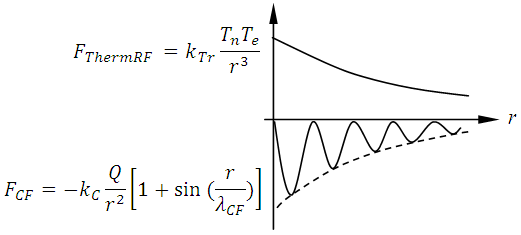 | Figure 1.3.2 |
The electrons on the different energy levels are stayed in the repulsive force and attractive force equilibrium positions or surface. At the positions, the attractive force will exert on the electron to draw it move backward when it moves forward, and the repulsive force will exert on electron when it moves backward to repel it move forward, as shown in Fig.1.3.3. 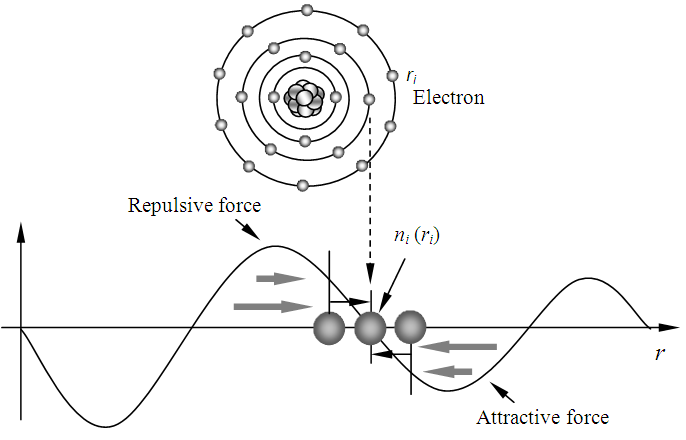 | Figure 1.3.3 |
1.4. New Explanations of Some Controversial Physics Assertions Based on Above Novel theory and Model will be More Reasonable, Accurate and Tenable
If we hold a fair scientific attitude toward the above mentioned newly discovered thermal repulsive force and newly proposed atom model, so as to make innovational reinterpretations for some physical arguments and physical phenomena, we will find out more new reasonable, accurate and tenable conclusions that differ from precedents.There were many examples of re-explanations of previous physical phenomena on reference and other materials; for example:
1.4.1. The Formation of Stellar Graveyard is Direct or Indirect Effect of the Thermal Repulsive Force
It is said that the dead stars are moving or concentrating toward the black hole or stellar graveyard and packed tightly together there. In other words, stellar graveyards are collecting dead stars.This is due to the reason that the decaying or dying stars, their temperatures are decreasing and becoming cooler and cooler than other normal galaxies. Then according to the universal thermal repulsive force theory, their thermal repulsive forces are decreasing; as a result, their gravitational (attractive) forces respectively (or relatively) appear larger and larger than other normal galaxies. Thus, results in the mutual attraction between the stellar graveyards and the dead stars are more strongly attracting each other than other normal galaxies; therefore the dead stars and the decaying star are moving toward the stellar graveyards rather.
1.4.2. The Exact Restoring Force or Elastic Force Caused by Bulk Modulus B of Sound Wave of Gas is the Universal Thermal Repulsive Forces between Gas Molecules
Any mechanical wave has restoring force or force caused by tension coefficient.For sound traveling through air, the elastic force caused by bulk modulus B makes the conversion of kinetic energy and potential energy constantly.  The restoring forces or the elastic force caused by bulk modulus B to sustain the propagation of sound wave of gas are exactly the universal static thermal repulsive forces of gas molecules that are interacting between gas molecules. The speed of sound V also depends on the temperature of the medium. The relationship between wave speed and medium temperature is
The restoring forces or the elastic force caused by bulk modulus B to sustain the propagation of sound wave of gas are exactly the universal static thermal repulsive forces of gas molecules that are interacting between gas molecules. The speed of sound V also depends on the temperature of the medium. The relationship between wave speed and medium temperature is  This exactly verifies and corroborates the elastic restoring force caused by bulk modulus B of sound wave of gas is the universal thermal repulsive forces between gas molecules.
This exactly verifies and corroborates the elastic restoring force caused by bulk modulus B of sound wave of gas is the universal thermal repulsive forces between gas molecules.
1.4.3. Thermal Repulsive Force Affects Turbulence
Turbulence is an unsolved problem. It is not known whether a general solution to the Navier - Stokes equations even exists. The kind of chaos inherent in turbulence is still a mystery. Newton's second law, F = ma gives rise to the Navier-Stokes equations. Euler writes down some equations for fluid flow which was derived from first principles. Cauchy developed the idea of the stress tensor viscosity (ν) and external force terms.We may note that if we take into account of the real time influence of thermal repulsive forces of the fluids (not only gases but also liquids) that are due to temperature changes of every infinitesimal element of the fluids and additional changes of boundary condition of heat sources (including heat radiation and heat conduction), then to modify or rectify the form of Navier-Stokes equations based on the universal thermal repulsive force theory, we could acquire more accurate computational solution of the Navier-Stokes equations that can fit the experimental data.In the following sections of this paper, more controversial assertions of physics and phenomena especially the superconductivity will be more accurately reinterpreted based on the newly discovered thermal repulsive force theory.
2. Re-Clarify and Accurately Define the Macroscopic and Microscopic Frictional Forces by the Universal Thermal Repulsive Force Theory
2.1. General Description
In physics it seems that we still do not understand what frictional force at macroscopic level is, and, at the microscopic atomic level there seems no friction. As we know, everything consists of atoms, so how can friction appear on macroscopic level? In fact, on a microscopic frictionless level, however, there are frictional forces between gas molecules, and electrical resistance can be considered as a measure of the frictional force in electrical current flow. The frictional force is prevailingly referred to as intermolecular force. However, what is the intermolecular force exactly defined and described?Since friction bleeds away energy in the form of heat, it implies that this problem is intimately connected with some of our other unknown mysteries - e.g. what are exact contact forces in microscopic and macroscopic level?To answer the above arguments, this paper clearly, frankly, and accurately claims that:Macroscopic frictional forces are microscopic frictional forces; macroscopic frictional forces are phenomena of microscopic frictional forces observed at our level and by our available macroscopic level tools. Both macroscopic and microscopic frictional forces are the universal thermal repulsive forces. All macroscopic and microscopic level contact forces are universal thermal repulsive force. When there are any acting and reacting forces on the contact surface, there are only contacting and acting on the thermal repulsive forces (fields) between particles (molecules, electrons and nucleus), but not any contacting between hard core of nucleus. For example, the frictional forces of gases flow are microscopic frictional force, are macroscopic friction also, they are universal thermal repulsive force. The electrical resistance actually is frictional force in electron flow, is actually universal thermal repulsive force between electron and nucleus.
2.2. Explaining and Describing the Macroscopic Frictional Forces by the Universal Thermal Repulsive Force theory
Assuming an external force or a gravitational force acts on a block, the block is moving in constant speed by a pulling force (should be equal to the frictional force), as shown on Fig.2.2.1, it is only the thermal repulsive forces field of molecules of the rough surface being in contacting.  | Figure 2.2.1. Detailed illustration of atom or molecules contacting |
We should clarify that it is only the thermal repulsive force fields to contact between the atoms or molecules of the rough contact surfaces but not the hardcore of the nucleus of the matter surfaces. Therefore undergoing the action of the contact forces, the mechanical volumes which being constituted by the thermal repulsive force fields are compressed; thus works are done on them then bleed out energy in form of heat. As shown in Fig.2.2.2.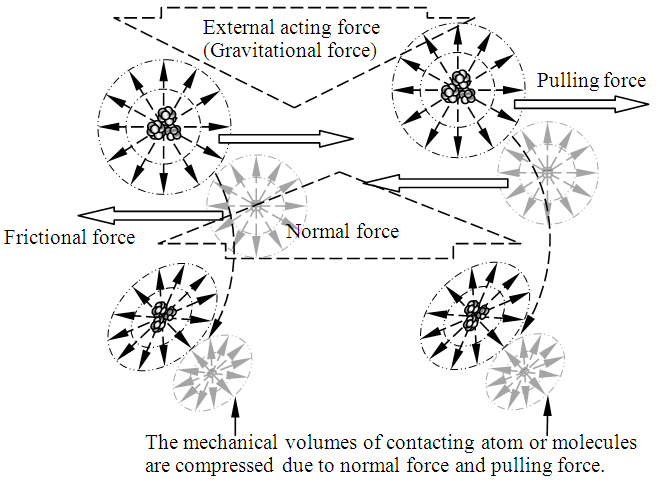 | Figure 2.2.2. Illustration of Compression of contacting atoms or molecules |
According to the universal thermal repulsive force theory (Eq.1.2.3), the molecules are point source of thermal repulsive force; their temperatures are inversely proportional to their mechanical volume. Frepulsive(Frictional)  .When the block is moving due to the pulling force, the mechanical volumes of contacting atoms or molecules are compressed due to normal force and pulling force acting and reacting, as shown in Fig.2.2.2.And, the rougher the contacting surface, and higher the moving speed and frequency, the more molecules are compressed repeatedly, therefore the pulling force (the frictional force) will do more work on the contacting molecules, then, more heat will generated, thus temperature of the contact surface will rise higher and higher.
.When the block is moving due to the pulling force, the mechanical volumes of contacting atoms or molecules are compressed due to normal force and pulling force acting and reacting, as shown in Fig.2.2.2.And, the rougher the contacting surface, and higher the moving speed and frequency, the more molecules are compressed repeatedly, therefore the pulling force (the frictional force) will do more work on the contacting molecules, then, more heat will generated, thus temperature of the contact surface will rise higher and higher.
2.3. Explaining and Describing Microscopic (of Electronic Level) Frictional Forces by the Universal Thermal Repulsive Force Theory
As shown in Fig.2.3, when the electrons are involved in current flow, they are encountering thermal repulsive forces between electrons and nucleus (i.e. prevailingly refer to as the electric resistance), the Coulomb force is doing work on them, the thermal repulsive force mechanical volumes of electrons are compressed repeatedly during pass through the lattices of crystal of the conductor, therefore based on thermal repulsive force theory, higher thermal repulsive forces compressed mechanical volumes of electrons and nucleus will bleed out energy in form of heat.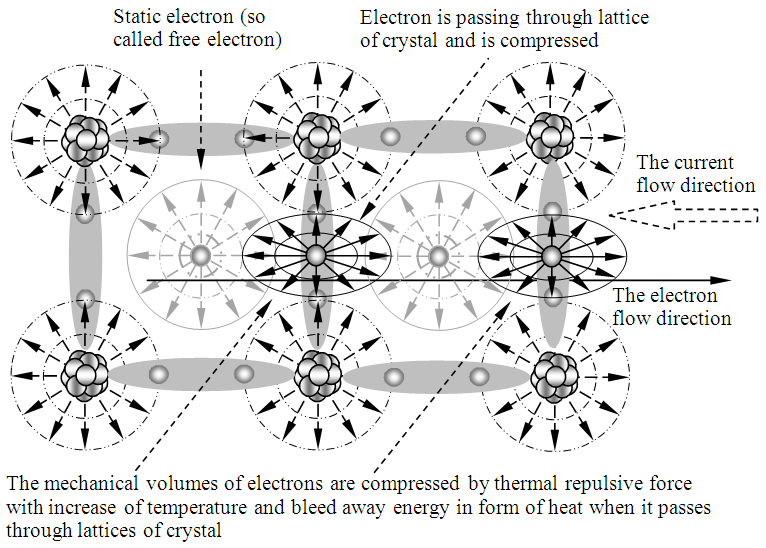 | Figure 2.3. Illustration of Compression of electron in current flow (electron flow) |
3. Accurate Re-explanations of Principle of (Thermoelectric Effects) Seebeck Effect and Peltier Effect Based on Universal Thermal Repulsive Force Theory
3.1. Accurately Interpretation of the Mechanism of Seebeck Effect Based on Universal Thermal Repulsive Force Theory Through Analyzing and Synthesizing the Physical Phenomenon
Thomas Johann Seebeck (1821) discovered the thermocouple. The thermoelectric effect is interchange of thermal and electrical energy. Thermocouple is a basic thermoelectric device consisted of two dissimilar metal wires connected at two difference temperature junctions. When one end of metal wire is heated to a high temperature than the opposite end, it caused the electrons diffuse to the cooler. This redistribution constitutes an electric potential difference between the junctions, as shown in the Fig 3.1.1. It refers to the Seebeck effect that makes the thermocouple operation. | Figure 3.1.1 |
3.1.1. Analyzing and Synthesizing the Physical Phenomenon of Seebeck Effect
The voltage or current of Seebeck effect is generated only by heat or high temperature (temperature gradient or difference). Meanwhile there is no chemical reaction during the process.Therefore it implies that there must be one kind of mechanical force to drive the electrons to flow pass the junction. And the force is associated only with thermal energy. Therefore we can infer that the force is exact equal to or proportional to the heat.According to the universal thermal repulsive force theory, when the temperature of the particle (point source) is increasing, its thermal repulsive force will increase, and the force is inversely proportional to the distance or its mechanics radii, r, from the point heat source.Then we can deduce the mechanism of Seebeck effect based on above analysis and the thermal repulsive force theory that due to the higher temperature of the hotter junction increasing the thermal repulsive force, then, the electrons of metal A and metal B at the region of hotter junction are compressed and are repelled to diffuse into surrounding region.Since the structures (of crystals) of metal A and metal B is different, there is a difference of the thermal repulsive force pressures between the electrons in metal A and metal B, the electrons of metal B is exerted higher thermal repulsive force than metal A, thus the electrons of metal B are passing through the junction and moving to metal A, as shown in the Fig 3.1.2.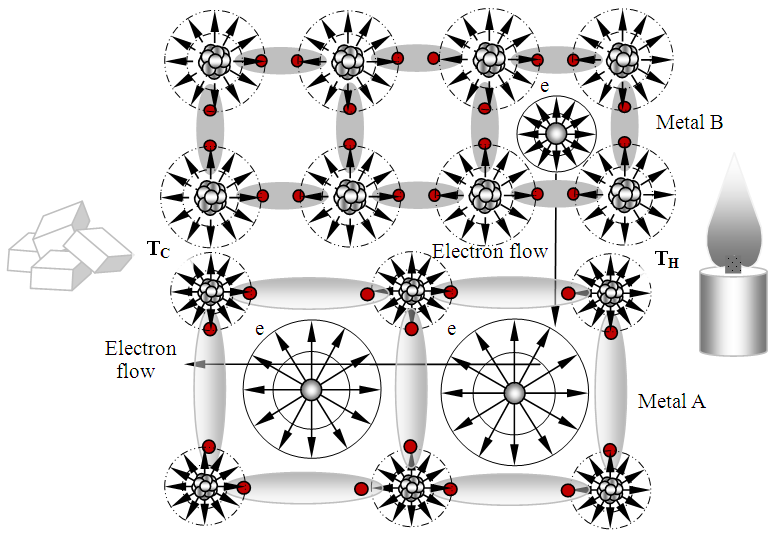 | Figure 3.1.2. Mechanism of a Seebeck effect |
3.2. Accurately Analyzing and Reinterpreting the Mechanism of Peltier Effect Based on Universal Thermal Repulsive Force Theory
3.2.1. Analyzing the Phenomenal Reality of Peltier Effect
Considering the p-type and n-type semiconductor as two black boxes, as shown in Fig 3.2.1, we will directly see that:1) The only function of the thermoelectric system is acting as refrigeration machine.2) The only actions of the cooling process in the black boxes are the inflow and outflow of electrons.3) What drives the electrons is an electric voltage (Coulomb force).4) Before and after the electrons flow in and out, there are no any changes of physical and chemical properties on the electrons (no chemical reaction occurs).5) Therefore it implies that the flowing electrons are refrigerant.6) According to the universal thermal repulsive force theory, electrons being the same as gas molecules are point source of thermal repulsive force.Then, we can infer that, the processes of inflow and outflow of electrons are compression or expansion process of the volumes of the refrigerant, just same as Freon or other refrigerants in air compressor of the air conditioners, the difference only lies in that the former is compressed by electric voltage (Coulomb force) while the later is by mechanical force of air compressor. | Figure 3.2.1. Consider p-type and n-type semiconductors as black boxes |
3.2.2. Details of the Mechanisms
Fig.3.2.2a and Fig.3.2.2b illustrates and depicts the mechanism and details of the refrigeration process by using electron as refrigerant.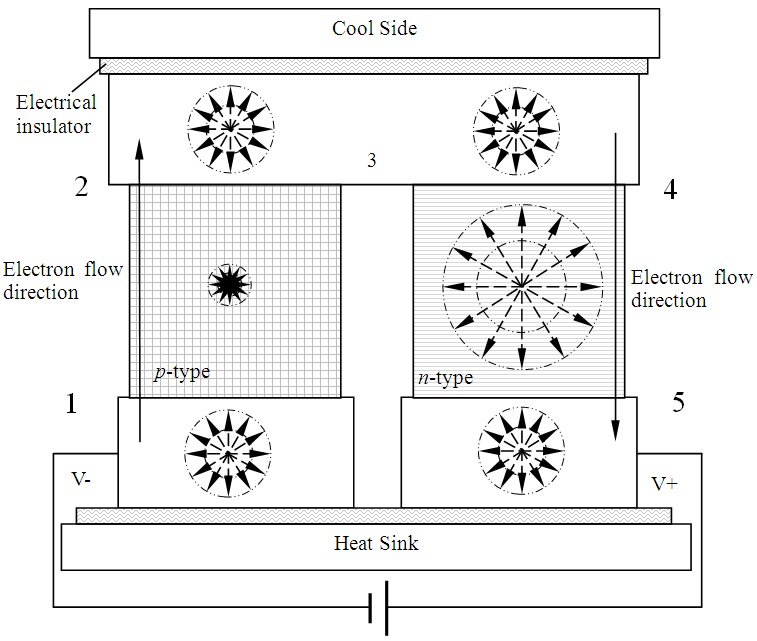 | Figure 3.2.2a |
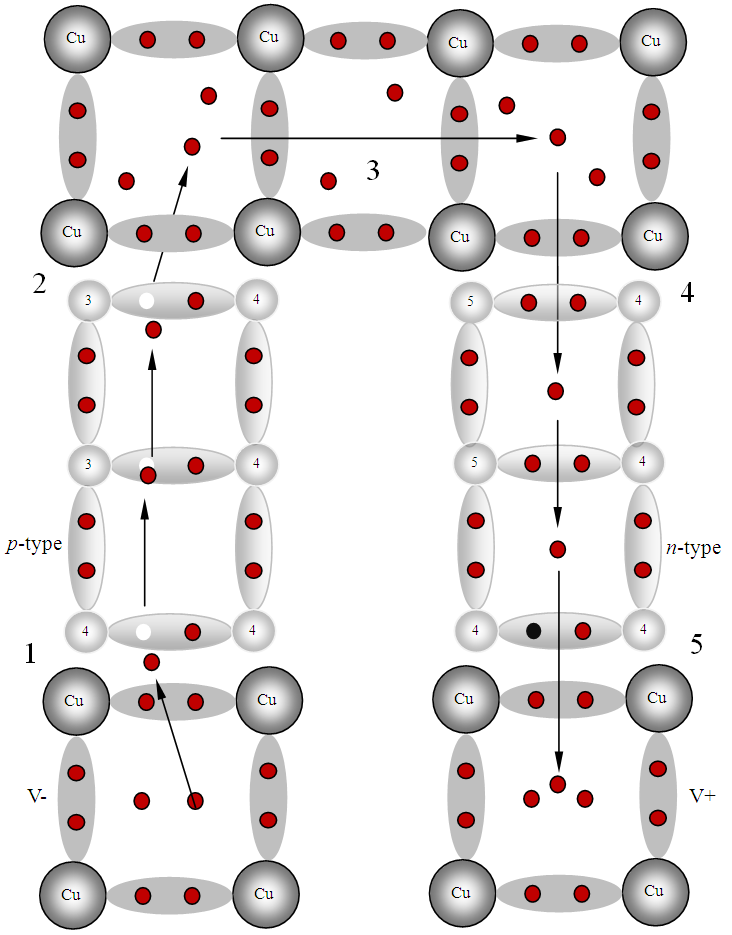 | Figure 3.2.2b. Details of the mechanism of a thermoelectric cycle |
Process 1, when the electron flows in the p-type semiconductor from conductor wire (Cu) of the negative pole of the power source (V-), the electron flows into a hole of the p-type semiconductor, its mechanical volume is compressed; it bleeds out energy in form of heat.Process 2, when the electron flows out of the p-type semiconductor goes in conductor wire (Cu), the electron flows out from a hole of the p-type semiconductor, its mechanical volume is expanded, it will absorb energy of heat.Process 4, when the electron flows in the n-type semiconductor from conductor wire (Cu), its mechanical volume is compressed; it bleeds out energy in form of heat.Process 5, when the electron flows out of the n-type semiconductor goes in conductor wire (Cu) of the positive pole of the power source (V+), its mechanical volume is expanded, it will absorb energy of heat.
4. More Accurately Re-describing and Re-explaining Superconductivity by the Universal Static Thermal Repulsive Force
4.1. Briefing Prevalent Descriptions of Superconductivity
Discovery: In 1911, Dutch physicist H. K. Onnes found that the electrical resistivity of a mercury wire disappears suddenly when it is cooled below a temperature of about 4 K (−269 °C). He soon discovered that a superconducting material can be returned to the normal state either by passing a sufficiently large current through it or by applying a sufficiently strong magnetic field to it.In 1933, Meissner discovered that a superconductor is highly diamagnetic; it is strongly repelled by and tends to expel a magnetic field. This phenomenon is called the Meissner effect. In 1953, in an analysis of the thermal conductivity of superconductors, it was recognized that the distribution of energies of the free electrons in a superconductor is not uniform but has a separation called the energy gap.Thermal properties of superconductors: In electric conductors, some of the electrons are not bound to individual atoms but are free; their motion constitutes an electric current. In a superconductor, there is an ordering among the conduction electrons that prevents this scattering. Consequently, electric current can flow with no resistance at all. The ordering of the electrons, called Cooper pairing. Most of the known superconductors are alloys or compounds.Transition temperatures: Superconductors have transition temperatures that lie between 1 and 100 K. Energy gaps: The thermal properties of superconductors indicate that there is a gap in the distribution of energy levels available to the electrons, and so a finite amount of energy, designated as delta (Δ), must be supplied to an electron to excite it. Magnetic and electromagnetic properties of superconductors: Critical magnetic field: One ways to force a superconductor into the normal state is to apply a magnetic field. The weakest magnetic field that will cause this transition is called the critical field (Hc).The Meissner effect: A type I superconductor in the form of a long, thin cylinder or ellipsoid remains superconducting at a fixed temperature as an axially oriented magnetic field is applied, provided the applied field does not exceed a critical value (Hc). Under the above conditions, the superconductors exclude the magnetic field from their interior. (If the magnetic field is applied in the same way to the same type of sample at a temperature above the transition temperature and is then held at a fixed value while the sample is cooled.) This is called the Meissner effect. Josephson currents: If two superconductors are separated by an insulating film that forms a low-resistance junction between them, it is found that Cooper pairs can tunnel from one side of the junction to the other. Thus, a flow of electrons, called the Josephson current.Mechanism of superconductivity: Interaction between electrons and lattice atoms is critical for the existence of superconductive state. Electrons on their flight through the lattice cause lattice deformation which results in a trail of positively charged region. This positively charged region of lattice atoms attracts another electron and provides for electron-electron coupling (Cooper pairs).The formation of collective state of Cooper pairs take place at T< TC. In the collective bound state the Cooper pairs do not scatter from the lattice and the conductivity of superconductor is infinitely large.BCS theory: Electron1 slightly displaces the positively charged atomic nuclei toward itself as it travels past because of the Coulomb attraction. Electron2 sees a region with a higher density of positive charge relative to the surroundings and is therefore attracted into this region and, therefore indirectly, to electron1. The only way for a lattice to scatter a Cooper pair is to break it up. Energy Gap: The formation of Cooper pairs leads to an energy gap between the superconducting state and the normal state. This gap means that it takes a certain amount of energy to break the pairs and destroy superconductivity.The destruction of one pair then destroys the collective motion of all the pairs. Below the critical temperature, there is not enough thermal energy available for this process, so the Cooper pairs travel unimpeded throughout the superconductor.
4.2. Reanalyzing the Phenomena and Prevailing Assertions and Reinterpreting Superconductivity Based on the Universal Static Thermal Repulsive Force Theory and New Atom Model
4.2.1. Reanalyzing the Thermal Properties of Conductors and Superconductors
The resistivity of some conductor materials such as copper, the resistivity increases with increasing temperature. In fact, in most conducting metals, the resistivity increases with increasing temperature, i.e., the resistance is proportional to the temperature T, vice verse, when the temperature of the conductor metal material is decreasing, the resistance of the material is decreasing, as shown in Fig.4.2.1.Formulating over a limited temperature range, the resistivity of a metal varies approximately linearly with temperature according to the expression | (4.2.1) |
where 𝜌 is the resistivity at some temperature T (in degrees Celsius), 𝜌0 is the resistivity at some reference temperature T0In electric conductors, the so-called free electrons may not be really free. According to thermal repulsive force theory and novel atom model, the free electrons are actually bound to or laid in weak chemical bonds of two atoms, or bound to lower energy level of its own individual atom [4]. At least any (free) electron is laid in an equilibrium state of thermal repulsive force fields of atoms and other electrons everywhere of the material.When the electrons are involved in current flow, they are encountering and passing through the thermal repulsive force fields (resistance) of other atoms and electrons therefore bleed away energy in form of heat.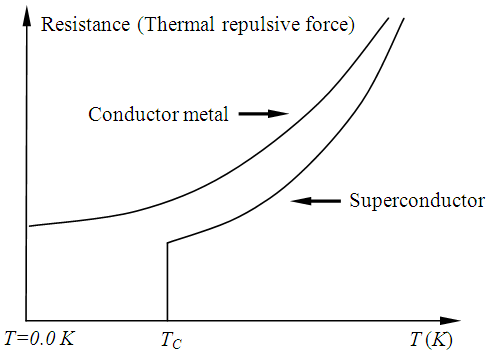 | Figure 4.2.1 |
In a superconductor, the resistance is proportional to the temperature T also, same as conductor when T > TC, vice verse, when the temperature of the superconductor material is decreasing, the resistance of the material is decreasing, as shown in Fig.4.2.1. The phenomena being mentioned above about conductor and superconductor imply that, both conductors and superconductors appear consistently conforming to the thermal sensitivity (thermo-resistor) principle.We then can infer that, when the electrons are involved in electric current flow, the resistances are only directly associated and proportional to the temperature. This is just exactly explained by the thermal repulsive force theory in section 2.3, i.e., the resistance is exactly the universal thermal repulsive force:
4.2.2. Reinterpreting Superconductivity Based on the Thermal Repulsive Force Theory
When the temperature of a superconductor is higher than TC, the electrons are laid in weak chemical bonds and laid in weak static equilibrium positions of thermal repulsive forces and Coulomb forces.When the temperature is lower than TC, the thermal repulsive force is lower so that the electrons are now in a relative free state. This relative-free state does not mean that there is no thermal repulsive force (resistance), it only means that when the electrons are moving under Coulomb force without bleeding away heat, i.e. it is an adiabatic process because the thermal repulsive force is very low and the speed of the electron is very high, so that no heat transfer occurs. For this reason the superconductivity exists only at low temperatures. Since the density of electrons inside any matter around nucleus is not higher enough to form Boltzmann’s distribution, so the free electrons are not laid in gas state, instead, they are laid in weak chemical bond or weak equilibrium between Coulomb forces and thermal repulsive forces. [4]In fact, the electric resistance should not be zero, if then, the electrons will be vehemently accelerated when voltage is applied on two ends of the wire, and the speed of electron thus will be infinite. Therefore, instead, the electrons are moving in weak equilibrium state of thermal repulsive force and Coulomb forces, a situation of adiabatic process with an approximate constant velocity. (Upon above analysis and explanation, we can infer that the Cooper Pair may not be existed.)Noting that, the electron is passing through lattice of crystal very fast and is slightly compressed so that temperature is slightly increased and decreased (restoring) rapidly with no heat transfer occurs, thus it is a adiabatic process with no energy in form of heat bleed out.The above description is the novel mechanism model of superconductivity that this paper would like to claim, the depiction of the novel mode is shown in Fig.4.2.2.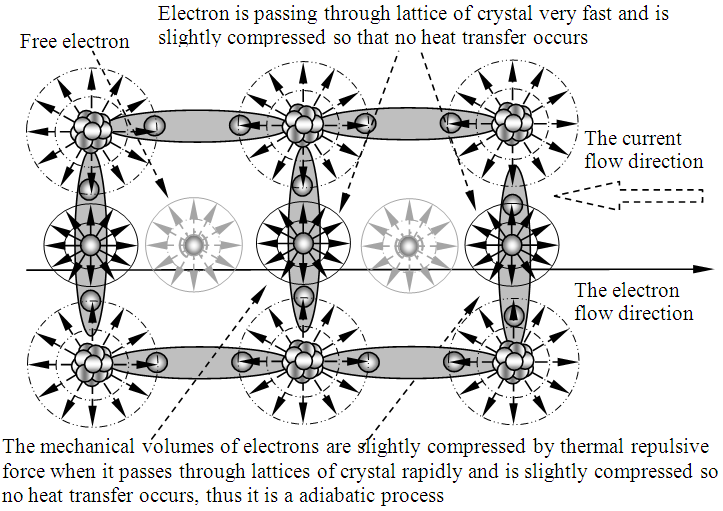 | Figure 4.2.2 |
4.2.3. Re-explaining Energy Gap
According to thermal repulsive force theory, when temperature T decreases, thermal repulsive force decreases, when the electrons are driving by Coulomb force, their speed will be higher, the thermal repulsive force (resistance) is lower, so the procedure is adiabatic process with no work done. The electrons are laid in superconductivity state.Therefore to excite the electrons back to normal state, a finite amount of energy of a gap is needed to supply to an electron to increase the temperature of electron to result in increase of the thermal repulsive force to reach a point higher than the adiabatic level, as shown in Fig.4.2.3.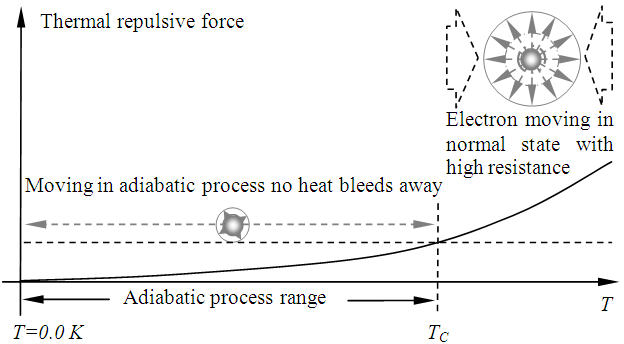 | Figure 4.2.3 |
4.2.4. Reinterpreting the Meissner Effect by the Thermal Repulsive Force Theory
A type I superconductor in the form of a long, thin cylinder or ellipsoid exclude the external magnetic field from their interior.We know the superconductor cylinder is under tremendous pressure (the pressure is actually thermal repulsive force), the gradient of the external pressure caused internal thermal repulsive force pressure field is distributed stronger to weaker from the periphery to the center of the cylinder. So the thermal repulsive force is higher at periphery region. Thus the electrons are forced to concentrate toward the centre of the cylinder, the density of like charges (negative charge of electrons) is becoming higher at center; the repulsive Coulomb force is then higher at center region.Because the response times of the electrons to thermal repulsive force and Coulomb force are different, therefore there is a phase difference between thermal repulsive force and Coulomb force; then the electrons move in motions of linear simple harmonic oscillation between periphery and center of the thin cylinder. As shown in Fig.4.2.4a.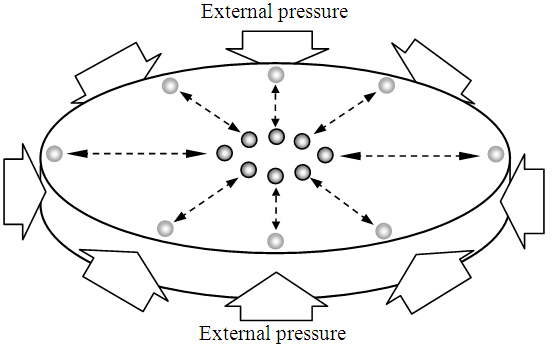 | Figure 4.2.4a. Electrons move back and forth reciprocally |
When a magnetic field is applied perpendicular to the cylinder, according to right hand rule, when the velocity vector of a charged particle makes any angle with the magnetic field, or is perpendicular to a uniform magnetic field, the particle moves in a circular path in a plane perpendicular to B. The magnetic force FB acting on the charge is always directed toward the center of the circle.The major premise of setting up interior electric current to expel magnetic field is that the electrons must be in linear motion in advance.As described above, the electrons are moving in motions of linear simple harmonic oscillation between periphery and center beforehand, when the axially oriented magnetic field is applied, (according right hand rule) it will induce the electrons to move in interior circular to generate an equal and opposite magnetic field to expel the external magnetic field. As shown in Fig.4.2.4b or Fig.4.2.4c.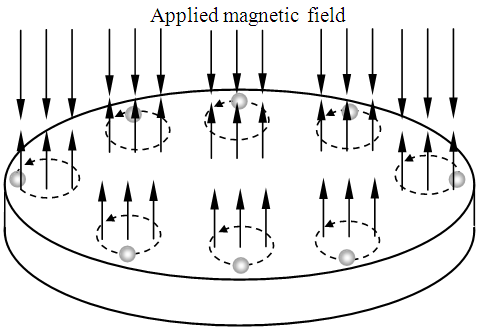 | Figure 4.2.4b |
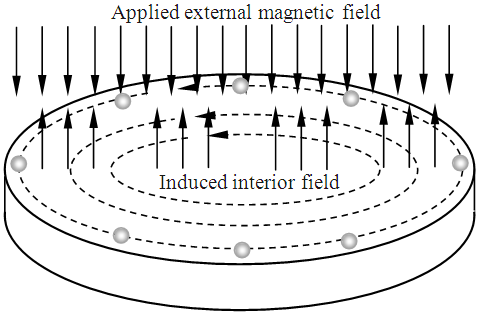 | Figure 4.2.4c |
For samples with other shapes, such as rectangle, because the electrons are not concentrated toward the center, and there may be some concentration effect resulting in higher density of electron only at corner region of the rectangle, so that, there may be some linear harmonic oscillation only at the corner region of the rectangle. Therefore such small region’s density of electrons is obviously higher than other zone, so there are linear harmonic oscillations of electrons in some corner regions. Therefore, some of the magnetic flux can penetrate through the middle zone and some fields applied on corner region are excluded. Therefore produce an incomplete or partial Meissner effect. As shown in Fig.4.2.4d.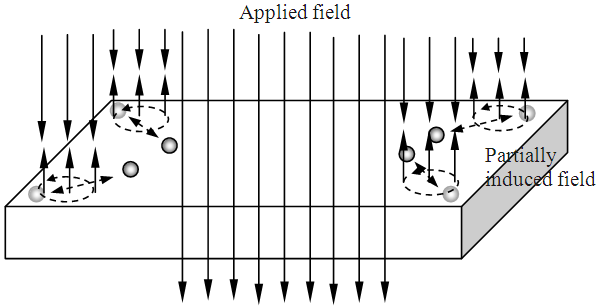 | Figure 4.2.4d |
4.2.5. Reinterpreting Josephson CURREnts
Similar to the condition for Meissioner effect, the gradient of tremendous pressure (thermal repulsive force field) is redistributed and different at the junction region of the two separated superconductors by the insulating film. The phase difference of thermal repulsive force and Coulomb forces at both sides cause the electrons moving in a motion of back and forth harmonic oscillation across the thin film.
4.2.6. Critiques of BCS Theory and Compare with Novel Interpretation
4.2.6.1aBCS theory fails to describe what is the initial starting off force to drive the motion of electrons of Cooper pair.If the electrons are absolutely free at the situation, there should be no electric resistance, then it is not necessary to form Cooper pair to achieve superconducting.If the electrons are at rest, what are the forces to act on them to sustain them in equilibrium? If it is only the conservative Coulomb forces to retain them in equilibrium, then, when they are moving, no energy in form of heat will bleed away, therefore there is no electric resistance anyway at this state with no need to form Cooper pair.4.2.6.1bCompare with the novel interpretation: The BCS theory never provides the details of how the resistance is decreasing and disappeared when temperature is decreasing.The novel interpretation is based on the thermal repulsive force theory, according to which, when temperature is decreased, the thermal repulsive force (i.e. the resistance) is decreased respectively, and when T is lower than a critical value Tc, the electrons under action of conservative Coulomb forces and much lower thermal repulsive force can move in higher speed without heat transferring, therefore it is an adiabatic process.4.2.6.2aIs the electron of Cooper pair moving in unidirectional or in a harmonic oscillation? Let us examine the mechanical energy of a mechanical harmonic oscillating system. There must be a continuous transformation between potential energy and kinetic energy by the restoring force, and the total mechanical energy must be constant. So, what are the potential energy and the elastic restoring force if Cooper pair is moving in harmonic oscillation?If the Cooper pair is moving in unidirectional, then where is the destination or end of a movement?If the Cooper pair is coupled to a large number of other Cooper pairs, then in the whole collective of Cooper pairs, we call the e1 and e2 being a Cooper pair, can we also call the e2 and e3 being a Cooper pair? What is more about e4, e5, and so on?If there are Cooper pairs, the electrons are moving in linear motions, when magnetic field is applied, there must be electrons moving in any angle with the magnetic field, or is perpendicular to the magnetic field, regardless of the different shapes of the superconductor samples (not must be long, thin cylinder or ellipsoid shaped), according to right hand rule, the applied magnetic field must induce the liner moving electrons to form interior circular current flow which creates magnetic field that exactly cancels out the external magnetic field. So, Cooper pair may not be really existed. 4.2.6.2bCompare with the novel interpretation:The BCS theory never tells us where is the end or destination of the movements of Cooper pair and collective of Cooper pairs. Thus BCS theory conflicts the conditions of Meissioner effect required.According to the thermal repulsive force theory, the electrons are laid in weak chemical bonds or in weak equilibrium rest state of thermal repulsive force and Coulomb force when T < TC. Therefore if there is strength gradient and phase difference of two kinds of forces between two internal zones of the superconductor material, the electrons will move in back and forth linear harmonic oscillation. This can explain Meissner effect well.So there should be no Cooper pair moving linearly and Cooper pair may not be really existed.
4.3. Further Discussions of Some Explanations
4.3.1. The Influence of External Pressure
When the experimental external pressure (i.e. the external thermal repulsive force pressure) is tremendous high, it could penetrates through the surface of sample and enters into the space between nucleus and electrons, acting on individual particles to homogenize the thermal repulsive force field surrounded the electrons, therefore no work is done when they are moving, as shown in Fig.4.3.1. | Figure 4.3.1. The external pressure could penetrates through the surface of sample |
The moving electrons without energy bleeds away in form of heat are due to two reasons.One is that temperature dropping decreases the thermal repulsive forces of particle elements to lower, therefore the electrons are moving in adiabatic process.Another reason is that the external pressure partially replaces the thermal repulsive forces of electrons and nucleus so that the electrons are actually moving on a homogenized suspension force field of penetrated external pressure, thus no work is done.
4.3.2. Try to Explain the Possible Mechanism of the Density Anomalies of Water (By the Way)
When ambient temperature is decreasing from 4 degree C, the internal repulsive forces of electrons and nucleus are decreasing, the external pressure (i.e. the external thermal repulsive force) penetrates through the surface of water (liquid or solid) molecules and enters into the space between nucleus and electrons, acting on individual particles to push the elements to increase the distance between them and lie in new equilibrium position. Thus the density of water increased with decrease of temperature from 4 degree C. More details and corroboration depends upon further deeper research in ways of this thinking mode. As shown in Fig.4.3.2.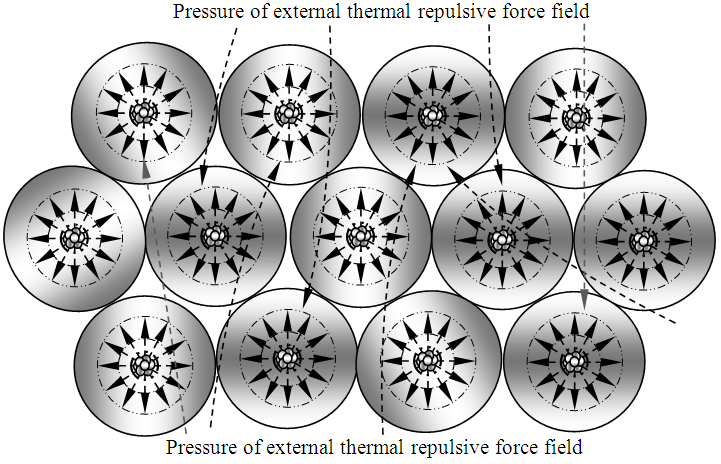 | Figure 4.3.2. Solid or liquid state H2O below 4 degree C |
4.4. Some Suggestions on the Research of Superconductivity
Currently, most of the researchers of superconductivity are seeking superconductivity materials that can work in a range of temperature and pressure of our every day level. Actually, what they expect a superconductor wire is quite similar to a vacuum tube that has no electric resistance.If we recognize that the electric resistance of any wire is exactly the thermal repulsive force, then we may realize that our expectations are in contradiction to the laws of nature. Any wire cannot be working under room temperature and pressure of our level like a vacuum tube for electrons to flow without resistance. In fact, the force to sustain the electrons floating in between the lattice of crystal of conductor and superconductor without falling downward attracted by gravitational force of earth is the thermal repulsive force i.e. the electric resistance exactly.Currently, we are working in an involution of wasting time and money, especially the research on superconductors that work at tremendous high pressure. For the purpose of power transmission only, we may try to research on the possibility of using vacuum tube to transmit electricity.
5. Conclusions
If the Universal Static Thermal Repulsive Force Theory is recognized as being correct physical law and truth of nature by mainstream of physics community, then, many microscopic, macroscopic and cosmological arguable and controversial phenomena, assertions and conclusions of physics can be well re-clarified and accurately reinterpreted by it.
References
| [1] | David Halliday, Robert Resnick, Jearl Walker: Fundamental of Physics (8th edition). John Wiley & Sons, Inc 2008. |
| [2] | Wolfgang Demtröder: Atoms, Molecules and Photons. Springer Oct 2010. |
| [3] | Liu Ke Dian: Discovery of a Universal Static Thermal Repulsive Force. American Academic Press 2022. |
| [4] | Liu Ke Dian: Correction of Fundamental Mistakes of Quantum Mechanics. American Academic Press 2023. |
| [5] | 9.9: Superconductivity. https://phys.libretexts.org/. LibreTexts. |
| [6] | Superconductivity. https://www.britannica.com/science/superconductivity. |
| [7] | J.V. Yakhmi. Superconducting Materials and Their Applications. https://iopscience.iop.org. |
| [8] | Liu Ke Dian: Derivation of a Most Reasonable Novel Atom Model. Physical Chemistry 2023, 12(1): 1-12 Scientific and Academic Publishing. |




 is power of r, T is the temperature in Kelvin. When the distance between two objects is longer comparing with the size of the objects,
is power of r, T is the temperature in Kelvin. When the distance between two objects is longer comparing with the size of the objects,  approaches 2, i.e.,
approaches 2, i.e.,
 approaches 3, the Frepulsive should be
approaches 3, the Frepulsive should be  , i.e.,
, i.e.,





 The restoring forces or the elastic force caused by bulk modulus B to sustain the propagation of sound wave of gas are exactly the universal static thermal repulsive forces of gas molecules that are interacting between gas molecules. The speed of sound V also depends on the temperature of the medium. The relationship between wave speed and medium temperature is
The restoring forces or the elastic force caused by bulk modulus B to sustain the propagation of sound wave of gas are exactly the universal static thermal repulsive forces of gas molecules that are interacting between gas molecules. The speed of sound V also depends on the temperature of the medium. The relationship between wave speed and medium temperature is  This exactly verifies and corroborates the elastic restoring force caused by bulk modulus B of sound wave of gas is the universal thermal repulsive forces between gas molecules.
This exactly verifies and corroborates the elastic restoring force caused by bulk modulus B of sound wave of gas is the universal thermal repulsive forces between gas molecules.

 .When the block is moving due to the pulling force, the mechanical volumes of contacting atoms or molecules are compressed due to normal force and pulling force acting and reacting, as shown in Fig.2.2.2.And, the rougher the contacting surface, and higher the moving speed and frequency, the more molecules are compressed repeatedly, therefore the pulling force (the frictional force) will do more work on the contacting molecules, then, more heat will generated, thus temperature of the contact surface will rise higher and higher.
.When the block is moving due to the pulling force, the mechanical volumes of contacting atoms or molecules are compressed due to normal force and pulling force acting and reacting, as shown in Fig.2.2.2.And, the rougher the contacting surface, and higher the moving speed and frequency, the more molecules are compressed repeatedly, therefore the pulling force (the frictional force) will do more work on the contacting molecules, then, more heat will generated, thus temperature of the contact surface will rise higher and higher.
















 Abstract
Abstract Reference
Reference Full-Text PDF
Full-Text PDF Full-text HTML
Full-text HTML